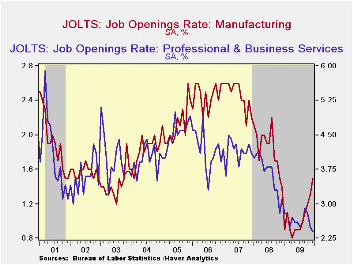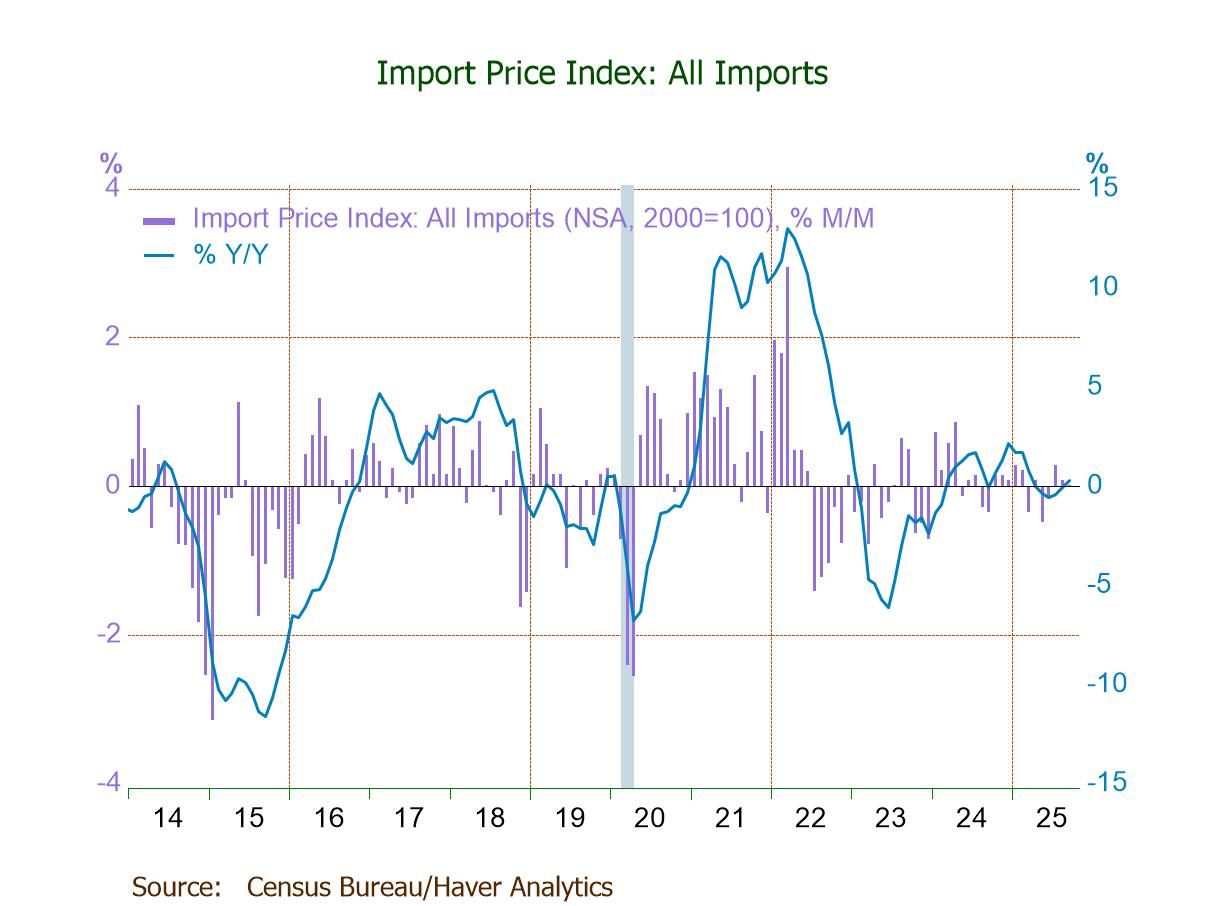 Global| Feb 09 2010
Global| Feb 09 2010JOLTS: U.S. Job Openings Improve Slightly
by:Tom Moeller
|in:Economy in Brief
Summary
The Bureau of Labor Statistics indicated that job market conditions changed little during December. The latest Job Openings & Labor Turnover Survey (JOLTS) indicated that though the job openings rate ticked up to 1.9%, it remained off [...]
 The
Bureau
of Labor Statistics indicated that job market conditions changed little
during December. The latest Job Openings & Labor Turnover
Survey (JOLTS) indicated that though the job openings rate ticked
up to 1.9%, it remained off sharply from the 3.1% rate when the current
recession began. The job openings rate is the number of job
openings on the last business day of the month as a percent of total
employment plus job openings. Job
availability rose 2.6% from November after two months of decline, and
remained off 22.5% year-to-year. The series dates back to December
2000.
The
Bureau
of Labor Statistics indicated that job market conditions changed little
during December. The latest Job Openings & Labor Turnover
Survey (JOLTS) indicated that though the job openings rate ticked
up to 1.9%, it remained off sharply from the 3.1% rate when the current
recession began. The job openings rate is the number of job
openings on the last business day of the month as a percent of total
employment plus job openings. Job
availability rose 2.6% from November after two months of decline, and
remained off 22.5% year-to-year. The series dates back to December
2000.
Earlier weakness in the service sector stabilized last month. Leisure & hospitality job openings ticked up 2.2% (-25.7% y/y), and educational & health service jobs rose 1.3% (-19.7% y/y). Finally, the number of government sector job openings ticked up 0.6% (-0.6% y/y). Offsetting these gains was a 3.7% (-26.2% y/y) decline in the number of professional & business service jobs. That was down for the third straight month. Though the number of retail job openings rose 24.9% (-27% y/y) that just made up a November decline. Countering weakness in service sector hiring was the factory sector where job openings rose for the fifth consecutive month and were off a lessened 6.9% y/y. Construction sector job openings posted a sharp 29.3% decline (-19.7% y/y) which reversed most of the prior four months' increases.
The hires rate remained stable for the fifth straight month at 3.1% but was slightly improved from the series' low of 3.0% last spring. The hires rate is the number of hires during the month divided by employment. The actual number of hires fell 1.3% m/m but was down 9.6% year-to-year. Professional & business service sector hires fell to the lowest level since June with an 18.2% decline (-15.9% y/y) while leisure & hospitality hires fell 2.7% (-3.8% y/y). Factory sector hiring fell 6.0% and was off a diminished 6.0% y/y however construction sector hiring rose 10.5% m/m (-2.2% y/y).
The job separations rate fell back to the series' low of 3.2% with the actual number of separations off 14.5% year-to-year. Separations include quits, layoffs, discharges, and other separations as well as retirements. The layoff rate alone ticked up to 1.6% but was down sharply from the January high of 1.9%.
The JOLTS survey dates only to December 2000 but has followed the movement in nonfarm payrolls, though the actual correlation between the two series is low.· A description of the Jolts survey and the latest release from the U.S. Department of Labor is available here and the figures are available in Haver's USECON database.


| JOLTS (Job Openings & Labor Turnover Survey) | December | November | October | Dec. '08 | 2009 | 2008 | 2007 |
|---|---|---|---|---|---|---|---|
| Job Openings, Total | |||||||
| Rate (%) | 1.9 | 1.8 | 1.9 | 2.3 | 1.9 | 2.3 | 3.1 |
| Total (000s) | 2,497 | 2,434 | 2,571 | 3,224 | 2,497 | 3,224 | 4,382 |
| Hires, Total | |||||||
| Rate (%) | 3.1 | 3.1 | 3.1 | 3.3 | 37.4 | 41.1 | 46.1 |
| Total (000s) | 4,073 | 4,125 | 4,045 | 4,508 | 49,448 | 56,486 | 63,666 |
| Layoffs & Discharges, Total | |||||||
| Rate (%) | 1.6 | 1.5 | 1.6 | 1.7 | 20.7 | 17.7 | 16.5 |
| Total (000s) | 2,079 | 2,011 | 2,128 | 2,360 | 27,594 | 24,362 | 22,613 |
Tom Moeller
AuthorMore in Author Profile »Prior to joining Haver Analytics in 2000, Mr. Moeller worked as the Economist at Chancellor Capital Management from 1985 to 1999. There, he developed comprehensive economic forecasts and interpreted economic data for equity and fixed income portfolio managers. Also at Chancellor, Mr. Moeller worked as an equity analyst and was responsible for researching and rating companies in the economically sensitive automobile and housing industries for investment in Chancellor’s equity portfolio. Prior to joining Chancellor, Mr. Moeller was an Economist at Citibank from 1979 to 1984. He also analyzed pricing behavior in the metals industry for the Council on Wage and Price Stability in Washington, D.C. In 1999, Mr. Moeller received the award for most accurate forecast from the Forecasters' Club of New York. From 1990 to 1992 he was President of the New York Association for Business Economists. Mr. Moeller earned an M.B.A. in Finance from Fordham University, where he graduated in 1987. He holds a Bachelor of Arts in Economics from George Washington University.






